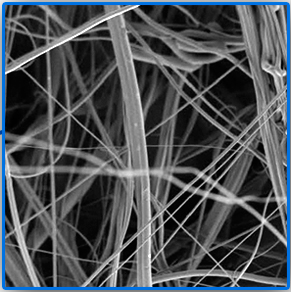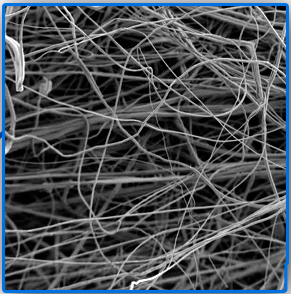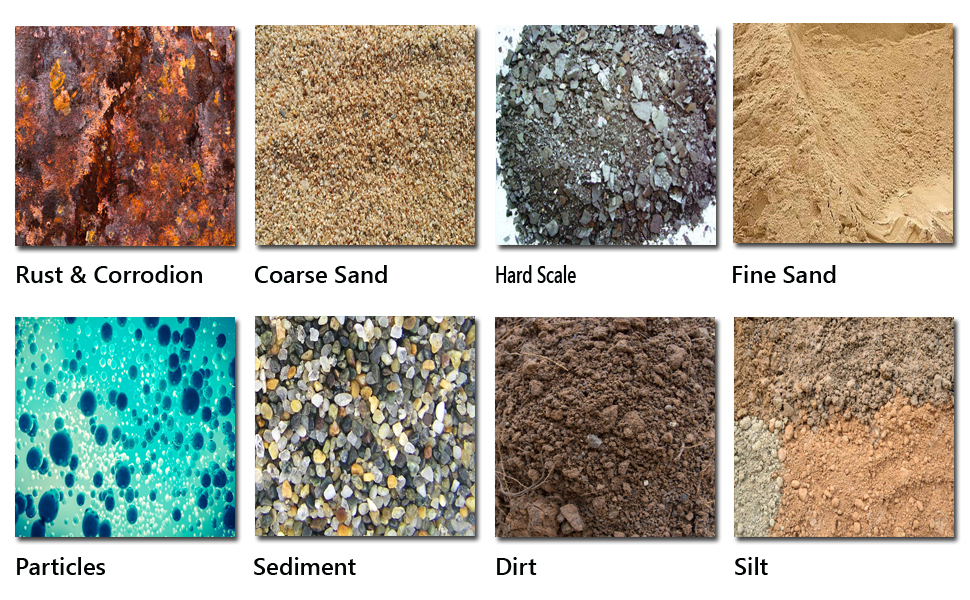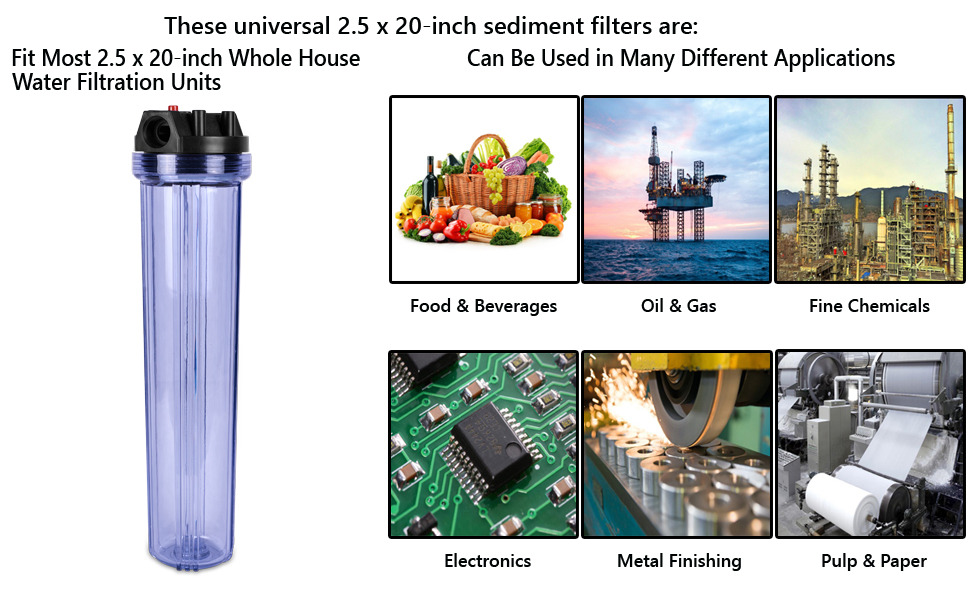Standard Whole House Melt-blown Four Layers Filtration Polypropylene 5 Micron Sediment Filter 20” x 2.5” Fits 20” x 2.5” Housings. Compatible with FPMB5-20, FPMB520, SDC-25-2005/4, VX05-20
4 Pack
|
 |
- 💎 Industry Standard 20-inch by 2.5-inch 5 Micron Sediment Filter - Used for effectively removing most sediments and any other undissolved particles from water. As the first line of defense in the filtration system, protect your water using appliances and plumbing structure from, improve water quality and taste.
- 💎 This is a filter for a Whole House Water Filtration Unit or any type of Water Filtration Unit with a 20 inch housing and WELL-MATCHED Models of Cartridges: Hydronix SDC-25-2005/4, iSpring FP25X25, Aqua-Pure AP110-2C, Cuno CFS124-C20, Tire1 P5-20, Everpure DEV910912, Neo-Pure PS-27200-05, MBG-25200-05 and SDG-25-2005, EVE155016-43 and EVEDEV910912, Hydrocure 31052000, SDF-25-2005
- 💎 Product Lifetime: Replace two or three times a year - depending on your water quality and application. Suggested change out when original water pressure dropped by 25 PSI
- 💎 Four separate gradient density layers enhance cartridge performance, higher dirt-holding capacity than the similar sized sediment water filter. This filter is wrapped and sealed and meets NSF (National Science Foundation) Standards and Regulations. Dimensions: 20 inches x 2.5 inches (48.8 cm x 6.35 cm)
- 💎 WELL-FIT FOLLOWING HOUSINGS: iSpring WCB32C, WCB32O and RCB3P, Geekpure 122-20, KleenWater A-KWHT2520-KW2520BR-Bracket-Wrench, LifeSource Water System 43208-530, BA-FH2025-CLR3
|
Polypropylene Multi-layer Gradient Filtration Cartridge
|
The 20" x 2.5" Sediment Filter is often the first filter installed in the Whole House Water Filter circuit. It is often the first point of contact between your water supply and your home and is used as a pre-filtration unit before the water continues to reverse osmosis and activated carbon filters. It catches unwanted particles, including sand, dirt, silt, rust, and other fine particles as they attempt to enter your house’s water system. These particles and pollutants come from water sources, old and dirty pipes, as well as contaminants that are used to treat the water.
These filters are made of fine-melted polypropylene that are blown and spun into cylinder-like form. Removal of these particles allows filters, such as Carbon Block or GAC (Granular Activated Carbon) filters, as well as household water appliances like boilers, ice-makers, and many more, to perform better for longer periods of time.
A Sediment Water Filter removes the physical debris and impurities from your water. The sediment filter has tiny holes which water is able to pass, however the unwanted particles are not. As these particles come in different sizes, so do the filters. The filter sizes are measured in microns, the smaller the micron measurement, the smaller the holes in the filter, allowing to hold back the smallest of particles. Generally, for water that is more visibly polluted, containing larger particles, a sediment filter of a larger size is recommended in the first stage of installation to prevent the clogging of the next stage of filters.
The main difference between a regular Sediment 10"x 2.5" Filter and a 20"x 2.5" Sediment Filter is the size, a 20"x 2.5" Sediment Filter is usually used for filtering the water on the entrance into the house, appropriately called whole house filter. It is able to filter a larger volume of water than a regular filter with its larger surface area, size, and radius |
 |
 |
 |
 |
Outer Zone |
Mid Zone |
Inner Zone |
Innermost Zone |
These Sediment Water Filters Intercept all Following Impurities |
- Rust & Corrosion- Rust is a type of corrosion. Corrosion is the process by which certain materials, metals and non-metals, deteriorate as a result of oxidation. Rusting is oxidation of iron in the presence of air and moisture. ... Corrosion requires surface exposure to air or chemicals
- Coarse Sand is our concrete sand that is washed and screened to a larger grit than our Fine Washed Sand (masonry sand). Coarse Sand is used with aggregate, water, and cement in the production of ready-mix concrete.
- Hard Scale causes a variety of problems in the home. Stains are probably the most noticeable result of hard water scale. Stains appear in toilets, sinks, and showers. Some hardwater scale are less noticeable, such as scale build up in pipes and in appliances which can cause costly repairs or the need to replace appliances.
- Fine Sand is very fine, screened sand that is typically tan in color. This type of sand is commonly used as base sand for above ground swimming pools, paving stones, sidewalk blocks and retaining walls. It is alternately used in stucco and cement applications.
- Particles is a small localized object to which can be ascribed several physical or chemical properties, such as volume, density, or mass. They vary greatly in size or quantity, from subatomic particles like the electron, to microscopic particles like atoms and molecules, to macroscopic particles like powders and other granular materials. Particles can also be used to create scientific models of even larger objects depending on their density, such as humans moving in a crowd or celestial bodies in motion.
- Sediment is a naturally occurring material that is broken down by processes of weathering and erosion, and is subsequently transported by the action of wind, water, or ice or by the force of gravity acting on the particles. For example, sand and silt can be carried in suspension in river water and on reaching the sea bed deposited by sedimentation; if buried, they may eventually become sandstone and siltstone (sedimentary rocks) through lithification. Sediments are most often transported by water (fluvial processes), but also wind (aeolian processes) and glaciers. Beach sands and river channel deposits are examples of fluvial transport and deposition, though sediment also often settles out of slow-moving or standing water in lakes and oceans. Desert sand dunes and loess are examples of aeolian transport and deposition. Glacial moraine deposits and till are ice-transported sediments.
- Dirt is unclean matter, especially when in contact with a person's clothes, skin or possessions. Common types of dirt include: Dust: a general powder of organic or mineral matter; Filth: foul matter such as excrement; Grime: a black, ingrained dust such as soot; Soil: the mix of clay, sand, and humus which lies on top of bedrock.
- Silt is granular material of a size between sand and clay, whose mineral origin is quartz & feldspar. Silt may occur as a soil or as sediment mixed in suspension with water and soil in a body of water such as a river. It may also exist as soil deposited at the bottom of a water body, like mudflows from landslides. Silt has a moderate specific area with a typically non-sticky, plastic feel. Silt usually has a floury feel when dry, and a slippery feel when wet. Silt can be visually observed with a hand lens, exhibiting a sparkly appearance. It also can be felt by the tongue as granular when placed on the front teeth (even when mixed with clay particles).
|
 |
 |
Extraordinary Dirt-Holding Capacity
- Superior contaminant holding capacity and superior flow rate compared to similar size sediment water filter cartridges.
- These cartridges will reduce sediment particles as small as 5 microns without adding taste, odor, or color to your water.
- Such filter cartridges are ideal for all residential, rural, commercial, industrial, and municipal applications.
|
 |
| Filter Type |
Fine Melted Polypropylene |
Flow Rate |
5 GPM |
| Height IN/CM |
20 IN/48.8 CM |
Operating Temperature |
40°F (4.4°C) - 125°F (51.7°C) |
| Outer Diameter IN/CM |
2.5 IN/6.35 CM |
Operating Pressure |
20 PSI (1.4 bar) - 125 PSI (8.6 bar) |
| Inner Diameter IN/CM |
1.125 IN/2.5 CM |
Product Lifetime |
Replace two or three times a year - depending on your water quality |
| Micron Rating |
5 MICRON |
Packaging |
This filter is wrapped and sealed and meets NSF (National Science Foundation) |
|